Topton L4Robert Jones | Guest Reviews The Topton L4 is a miniature laptop with a 7” touchscreen and a quad-core Intel Celeron processor, running Windows 10. It caught my eye both for its superficial resemblance to a H/PC and for its low price – much lower than apparent equivalents like the GPD Pocket or One Netbook devices. The specs would suggest that it represents remarkable value for money – but is it too good to be true? In this review I will explore the machine and its capabilities and shortcomings, and hopefully answer this question. There seems to be no definitive manufacturer or supplier for the device, so as such it is difficult to give a guideline price, however it is available online for between $250 and $400 USD, depending on the seller and amount of storage specified. There are some listings on Aliexpress for well over $500 but I am ignoring these as I refuse to believe anyone is buying it at this price. I was able to pick up my review unit from Aliexpress for £179.71 GBP ($217.45 USD, €206.67 EUR, ¥32,464.61 JPY est.). As of this review, however, the lowest price I can find is around £210 GBP. First of all - I’ve chosen to use ‘Topton L4’ as the name for this device as that seems to be the name used most frequently in reference to it online, but it’s available under a plethora of different names and apparent brands. I’ve not been able to identify the actual manufacturer, and in fact in most cases it is supplied unbranded, indeed with no text at all on the casing. Just to add to the confusion, some sellers provide an option for you to to add your own branding while other resellers ship it as a branded device (as in the case of Toposh). For your interest / amusement, some of the other names it’s sold under are: There is no difference between any of these devices, the only variation in spec can be found in differing storage options, typically between 128GB and 1TB. If you’re considering buying it, I’d advise just getting it as cheap as you can from the most reliable seller you can find – no supplier appears to offer any sort of after-sales support or even supply drivers so you’re essentially on your own once you’ve bought it. With the naming confusion out of the way (possibly), on to the actual review! In the interest of clarity I’ve split this into sections covering the different aspects of this machine. 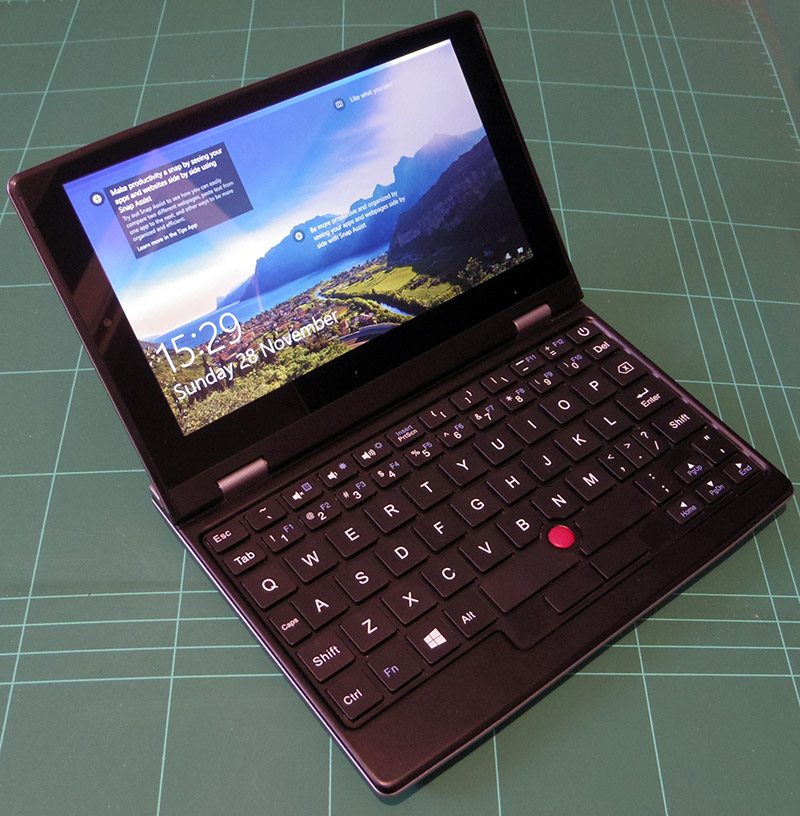
PackagingThe L4 is supplied in a plain black box with ‘Pocket Book’ on the top (yet another name?) Inside is the device itself and a charger. There is also what I assume is a quick start guide, written in Mandarin (I also assume) with no English translation, which is disappointing. Aside from this, the device is wrapped in plastic films that cover all of the outer surfaces keeping it protected as it got passed around the assembly line, but there is nothing remarkable here. It is minimalist and functional, not exceptional. Body / CasingThe L4 is pleasingly small, as you would hope given the screen size, though not as compact as the GPD Pocket or One Netbook devices. The main reason for this is that the body extends behind the lid hinges by approximately 25mm / 1”. This extension also means the lid cannot fold out to 180 degrees, instead stopping at approximately 130 degrees. I’ve not found this to be much of a hindrance in use, and the extension provides a ‘handle’ of sorts when using it handheld. Dimensions are not as compact as might be hoped based on the screen size, in comparison with the GPD Pocket 2 for example: Topton L4: W 185 x D 141 x H 20mm, 650g (W 7.31” x D 5.6” x H 0.8”, 1.4lb) GPD Pocket 2: W 181 x D 113 x H 14mm, 465g (W 7.13” x D 4.45” x H 0.55”, 1lb) The additional depth in particular, along with its weight, mean it cannot realistically be considered ‘pocketable’. It is certainly compact, small enough to fit in a handbag, a small pocket in a backpack, or a car glovebox. I’ve even managed to get it into a compartment in my camera bag designed to fit a small tablet. Given that it’s not constrained by the need to fit in a pocket though, it’s a little disappointing that the opportunity to fit in a larger screen was not taken – The chassis would certainly accommodate an 8” panel. The base of the main body is aluminium and the rest of the case plastic. It feels very solid, with no real flex anywhere. It is however unclear what benefit the aluminium provides – It is not structural, as in many aluminium-bodied laptops, nor noticeably thinner than the equivalent plastic part would be. It does appear to form part of the heat dissipation system, but given the space inside and the active cooling, this role could just as easily have been fulfilled by fitting a proper heatsink instead. I suspect it was more for marketing purposes; with all the listings for the device mention its aluminium casing. It does of course add more weight than if it were plastic, so if anything I would consider it detrimental to the device. The screen hinges are smooth and reassuringly stiff – hopefully they stay this way, as this potential issue should be of particular concern with touchscreen devices. This stiffness does mean that opening the device is a two-handed job otherwise the lid will lift up the whole machine if not restrained. 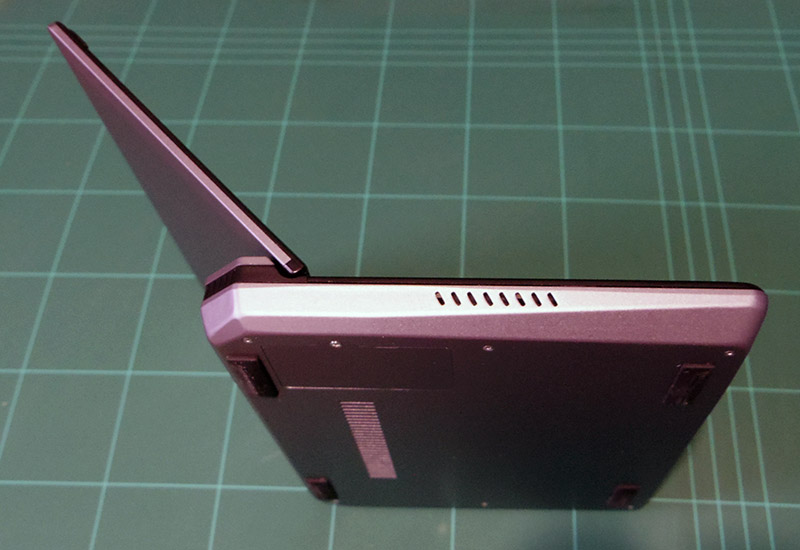
On the bottom of the case is a little access cover for the SSD compartment, retained by a Phillips screw, which reveals a single SATA-capable M.2 2242 slot. The supplied SSD has no apparent branding and is very slow (136MB/s read, 132MB/s write). Opting for the larger storage options would appear to offer good value vs. buying a larger SSD separately, however the questionable quality of these parts should be taken into account – can an SSD that offers read/write speeds more akin to those of a mechanical hard disk really be compared to any ‘proper’ SSD? For anyone interested in the L4, my recommendation is to go for the cheapest model that you can find (usually the 128GB version) and then upgrade later with a quality part such as the at your preferred size. Thankfully this is easily done via the aforementioned cover. Unfortunately however it is worth noting that the device does not support NVMe drives, just legacy SATA ones. 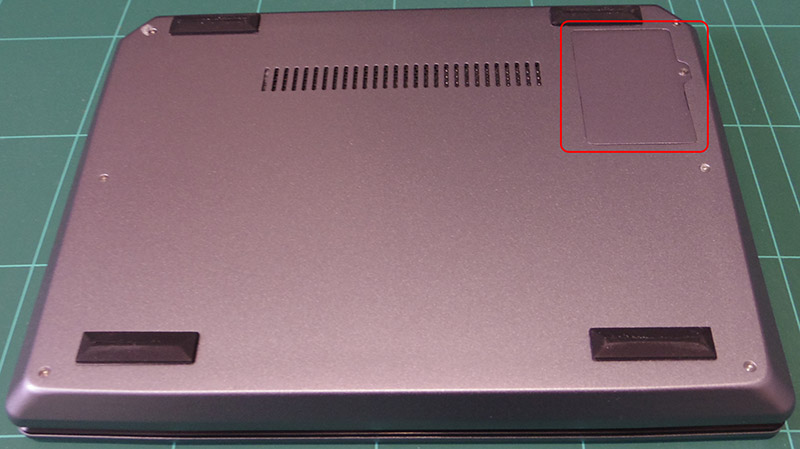
The right side of the unit sports a USB (A) port, a 3.5mm jack socket for headphones and microphone, and a microSD card slot. On the rear is another USB port, a mini-HDMI port and the charging socket. It would have been nice to have all the ports on the rear given that the layout of the device would seem to allow this, but in use it is not bad with the sockets you’re most likely to have cables plugged into in for longer periods are at least on the rear side and out of the way. ScreenOpening the display reveals a 7-inch (17.8cm) screen surrounded by roughly 1cm (0.4") bezels all round. I was a little worried about the screen resolution before the L4 arrived. At 1024 x 600 it’s definitely on the low side, especially when compared to other 7” devices with Full HD screens. In practice, however, I’ve found it fairly usable in both Windows 10 and Kubuntu. Some applications will struggle with the lack of vertical resolution of course, but nothing I’ve yet tried has been unusable. Other than this, it is a decent screen. It is bright and offers wide viewing angles that strongly suggest that it is in practice an IPS panel. Touch input is sensitive and accurate with Windows claiming 5 touch points and swiping / pinch-to-zoom etc. all working as expected. The one fault I would note is that the screen on my particular unit has a region at the very top that appears brighter than the rest of the screen. This is not parallel and looks as though there is some sort of filter or similar that is misaligned. I am more inclined to believe that this is an assembly or quality control issue than anything wrong with the screen itself, although it does potentially point to inconsistency in individual units and poor-quality assurance which may ward off some users. In practice however it is not much of a problem in use and I’ve found myself forgetting about it after a short time. It would be interesting to see if other units have a similar defect, and the degree to which this varies? 
Keyboard / Stick PointerThe keyboard section of the unit is a metallic grey colour, with the keyboard and its surround in matt black plastic. It appears to be a close copy of the one on the original GPD Pocket. This layout appears to have been designed with the intention of maximising the space available for the letter keys, with the result that a number of keys are half-sized or unusually placed. The keyboard includes special keys for volume adjustment (Up/Down/Mute), with screen brightness control available using the Fn key and volume up/down keys. The Fn key is used to provide the standard function keys, with F1-F10 on the half-height number row and F11-F12 on the top row (also half-height). It also provides PgUp/PgDn/Home/End via the arrow keys, which are again half-height. Half-width keys are employed on the letter key rows, being used to fit in CapsLock in its standard location and the comma/period/forwardslash keys, again in their standard location. Other punctuation and special characters are somewhat haphazardly located, with the top row of the keyboard seemingly being used to ‘dump’ most of these. Only a US QWERTY keyboard layout is supplied with most sellers seeming to offer a set of stickers to ‘convert’ to other key layouts on request. Stickers are offered for the following key layouts: Arabic, German, French, Hebrew, Italian, Japanese, Korean, Russian, Spanish and Thai. 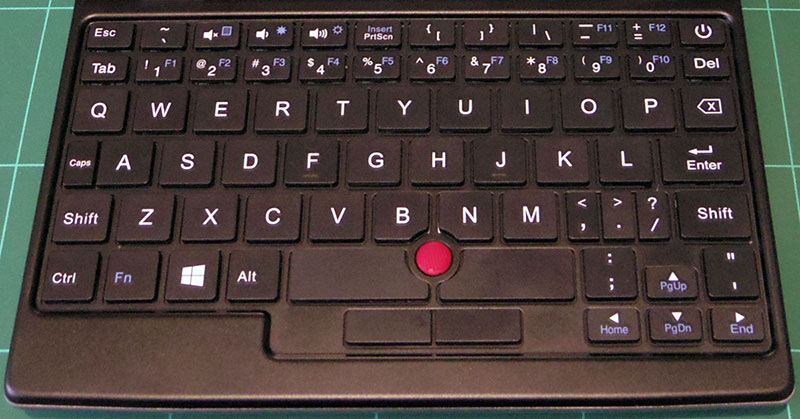
The keyboard, inevitably, takes a little getting used to due to its unusual layout. Some may find the lack of Right Ctrl / Right Alt keys jarring - I’ve never got in the habit of using these much so don’t really feel the lack of them. The keys themselves are quite pleasant, with a decent amount of travel, although they could perhaps stand to be a little stiffer. There is no noticeable flex in the keyboard deck and it feels well supported. The keys would probably feel nicer with slight depressions in the surface, rather than completely flat as they are. This is perhaps a little harsh as the same criticism would apply to probably the majority of ‘chiclet’ style keyboards. The tight spacing means that it is not particularly comfortable for extended typing, at least for those with large hands like myself. I had indeed hoped to write the bulk of this review on the device itself, however I ended up resorting to a ‘proper’ keyboard. For note-taking, emails, and other light usage it is acceptable. I can’t imagine gaming on it being pleasant for anything more than short periods as the awkward positioning of the ‘WASD’ keys and half-size arrow keys would pose issues for any games using these keys. The Trackpoint-type stick pointer works as expected and complements the touchscreen well, allowing more precise input when required. Buttons are fairly well-placed although as supplied they are set up weirdly. As supplied, the left mouse button is set to produce a ‘click’ rather than having the ability to 'hold' the button down (meaning no ‘drag’ actions are possible). A bit of digging revealed that the left button action was achieved using Windows’ ‘Ease of Use’ settings and that both mouse buttons were in fact just presented to the OS as keys on the keyboard - the left button being the ‘5’ key on the number pad and the right being the ‘context menu’ key. A clean install of Windows resulted in the left mouse button no longer working, which is particularly annoying. Thankfully I was able to gain proper function via AutoHotkey and a very simple script (provided at the end of this review), however as an oversight in the hardware or driver design of this device, this is particularly worrying and points again toward a certain ‘laziness’ in design, or disregard towards the user. As with most laptops, you either love or hate the trackpoint style input devices. If you don’t get on with this style of pointer – well you won’t like this one either, although you can easily connect an external travel mouse via a USB port or via the built-in Bluetooth. PerformanceThe performance of the L4 was a pleasant surprise. The device feels fast, definitely when compared to comparably sized Intel Atom-based devices. The late-2016 Intel Celeron J3455 processor is pretty weak by today’s standards, clocking in with 4 cores and 4 threads at 1.5GHz with a boost of up to 2.3 GHz. I can only assume that the relatively generous 8GB of RAM and SATA SSD help a lot here (although unimpressive compared to NVMe drives, a SATA SSD is considerably better than all but the fastest eMMCs, as are commonly fitted to devices in this class). GPU performance is no more than adequate. The on-chip HD Graphics 500 was at the low end of Intel’s offerings even in 2016. It supports DirectX 12 and OpenGL 4.6 and so can be used for gaming, but you will achieve playable framerates only in casual or indie games, or older games (2011 or earlier would be a good rule). I have not tested extensively but I would imagine many newer games may also have issues with the screen resolution – The only gaming-oriented device of recent years with a comparably weak processor would be the GPD Win, which has a 1280 x 720 pixel screen. DOS and console games via emulators should not pose issues, again provided you don’t try to emulate anything much newer than the N64 / Playstation 1. CoolingDevice thermals are well controlled and the machine never gets more than slightly warm to the touch, despite the internal heat spreader being linked by a thermal transfer pad to the bottom casing. There doesn’t appear to have been any particular effort to optimally direct airflow through the chassis or across the motherboard. The ‘heatsink’ consists of two respectably sized plates laid on top of one another that covers most of the motherboard but only make contact with the CPU via thermal paste and does not provide thermal relief for any other component. The fan's intake is on its underside at the bottom and the rear, and air passes through the case and exhausts through a small vent on the left side of the machine. Unfortunately, in this design the cooling fan is on permanently (except in suspend mode or when shut down) and worse it runs at constant speed that seems unrelated to temperature or system load. Thankfully the fan is not loud, barely audible over moderate background noise, and the pitch is not high or irritating. The bulk of the sound seems to be airflow rather than motor or bearing noise. I have thus far been unable to control fan operation in any way, even by manually operating the embedded controller’s registers. From looking at the motherboard I think it is likely to just be a DC fan that is just wired to a convenient power source, and not a PWM style fan that is intelligently connected into the chipset’s management controller. Given that the J3455 CPU is used in a number of fanless devices and is more than capable of temperature throttling its base clock, I would consider adding a switch to deactivate the fan entirely, albeit at the cost of some performance during high load. As supplied, the lack of some degree of fan control and the total absence of a reduced-functionality silent operating mode is a little disappointing. 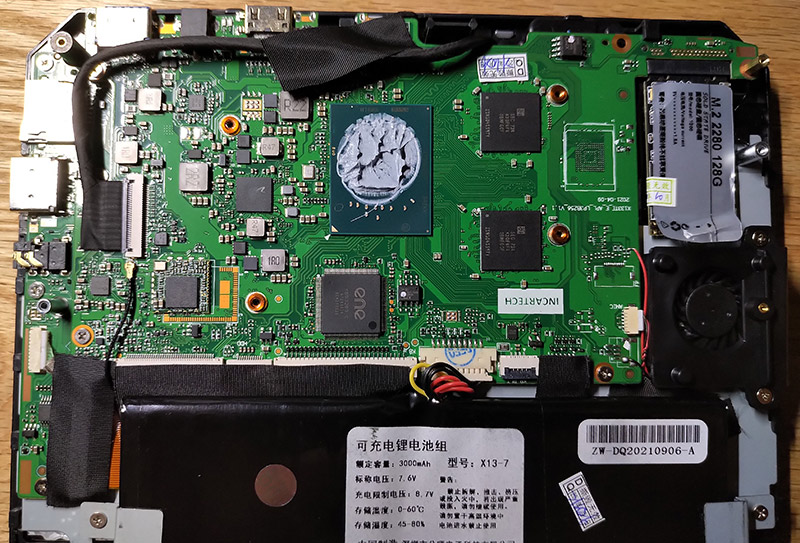
Battery / Power UsageBattery life in mixed use is around 2 hours on its 3000mAh, 7.6v Lithium Ion battery. Sadly this rather undersized offering only leaves a predicted battery life that always weighs in at around 2 hours - regardless of load - so I suspect power usage is not being reported properly by the chipset. The battery information provided by Linux would appear to back this up, showing a discharge rate of 11.2W whatever load is applied and whatever the screen brightness is set to. This poor battery life is incredibly disappointing for a 2021 device, released in a market where 20+ hour devices are becoming common-place. Windows ‘Battery Saver’ mode appears to help somewhat in this regard, extending the battery life to 2 hours and 50 minutes - still far short of acceptable. Unfortunately, a full charge takes around 2 hours via a 12v 2A charger with a barrel jack connector, which is roughly 1:1 equivalent to its average discharge time, adding to the frustrations. Despire this, it does go into proper suspend-to-ram from the power button or by closing the lid, and resumes in a little over 1 second. Audio & WebcamThe speakers can be found behind the lid although they are not loud, the are clear sounding. This is probably not a bad thing given their size. The webcam is poor even by laptop webcam standards, being oddly placed halfway up the left side of the screen, and produces unusually desaturated images with a reddish tint. The poor (fixed) focus and noisy image means the 1.9 megapixel resolution is almost meaningless as the 'usable' resolution is probably sub-VGA (see sample photo below). There is a microphone on the right hand side which picks up quite a bit of fan noise but is usable. 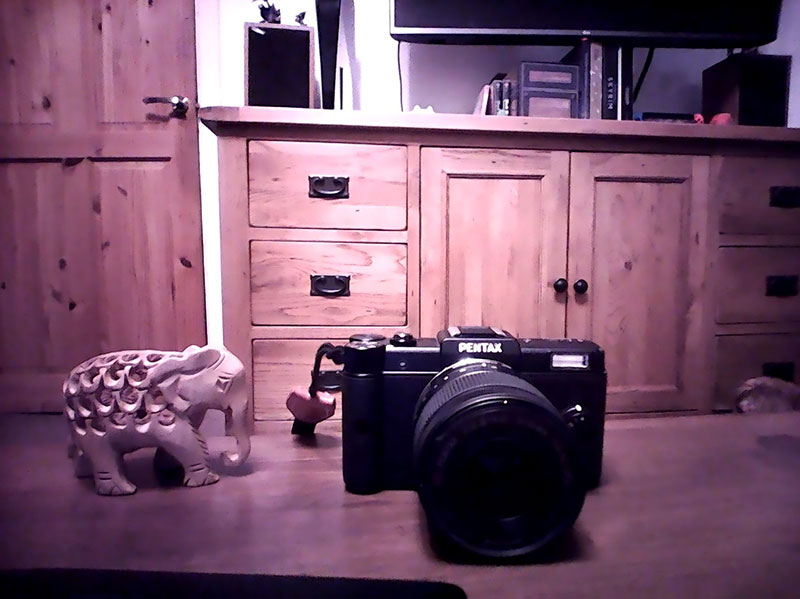
A single combi audio jack provides analogue headphone / microphone support for an average audio experience. While the headphone output is clear, there is some hum on the microphone input and while I’ve not tried any adjustments to suppress this, anyone thinking seriously of using this would want to invest in a USB or Bluetooth solution. OS / SoftwareThe supplied copy of Windows 10 Home is oddly set up (does not allow Windows updates) and has Office 2007 installed for some reason. This, along with the fact that no license key or any information pertaining thereto is supplied, strongly suggests that the supplied OS is not legitimately licensed. This should be taken into account when considering the price of this device – I would not want to operate Windows for any length of time without access to security updates, so the cost of a Windows licence should be added to its apparent purchase price. Alternatively you can opt to use Linux instead. I ended up doing a clean install of Windows and - as you might expect - had to use my own license key to activate it as there is no key tied to the hardware, and unsurprisingly no recovery media is provided either. I went to the extra step of backing up the drivers (see link at the end of the review) and after the reinstall was able to get full hardware support restored without any issues; and I suggest that you take this precaution. Before restoring the drivers there were a large number of ‘unknown’ devices shown in Device Manager – This is somewhat odd given that the internal devices are mostly standard Intel components and part of the SoC – I do not have an explanation for this, except perhaps that Intel have opted to leave driver support to the OEMs for processors like the J3455. It is worth noting that Windows 11 cannot be installed on this machine. While it allegedly supports TPM 2.0 the ‘PC Health Check’ check tool provided by Microsoft lists the processor as being unsupported by Windows 11. A look at the supported CPU list for Windows 11 shows support starting from the generation of Celeron/Pentium processors after this one (N4000, N4100 etc.) so it is highly unlikely that support will be added in future. I also tested the L4 with a clean install of Kubuntu, this was straightforward but I had to install a special driver from Github to enable Wifi and as of writing I have been unable to get the sound working. While I believe there is a kernel driver that can be built for the chip involved and that the driver is likely to be included in a future Linux version, this highlights "typical Linux" issues and that Linux may not offer a quick way out for all but the determined and experienced user. Despite this, all other hardware appears to work without issues – although the obscure mouse button mapping persists in Linux, but as in Windows is fixable. Under Linux, I have not observed any meaningful difference in power consumption or battery longevity, though with the greater opportunities for tinkering afforded by Linux this may change in future. The one real difference I have observed is that the screen can be set to be darker in Kubuntu than it can in Windows – I suspect a driver and configuration issue in Windows, as here the three lowest levels of brightness adjustment are the same. Spec corrections & clarificationsAgain, perhaps showing the quality and lacking attention to detail in some areas surrounding this device, the specification that you may typically encounter for the L4 tend to come with some factual inaccuracies and inconsistencies. For this reason the full, accurate specification is provided below. I have highlighted where this differs from the spec as advertised.
* Note on claimed USB 3.0: The specs state that the rear USB port is USB 3.0. While both ports have the extra pins for USB 3.0 and I had hoped that this would mean it had two USB 3.0 ports, my tests with a SATA drive in a USB 3.0 enclosure gave speeds well below USB 2.0 limits on both, topping out at about 40MB/s. The same drive tests at around 300MB/s when connected to a USB 3.0 port on my desktop PC. Device info in Kubuntu shows both USB 3.0 and USB 2.0 hubs, but devices plugged into either socket are shown connected to the USB 2.0 hub, along with the Wifi device and microSD card reader. It’s possible that this is a driver / config issue but I’ve found nothing to support this so far, if it truly is connected this way internally it’s a baffling design decision and disappointing, not to mention dishonest. VerdictIt has been pleasing for me to see so many devices in this category appear in recent years. For the purposes of this review I am defining the category as ‘Highly compact devices with a clamshell or sliding keyboard design, with a screen size of less than 10 inches’, namely the niche in which H/PCs and later the UMPCs existed. The resurgence of such devices has been an especially pleasant surprise for those, like myself, who had assumed this type of device to be long extinct - replaced by massively more popular iPadesque devices and of course the ubiquitous smartphone. This shift doesn't work for everyone and the general move of mobile computing devices towards ever more content consumption, and away from being platforms for productivity and creativity can be a real issue for certain classes of users. Yet the rise of crowdfunded hardware has brought back, and to some extent created anew, a little world of compact ‘proper’ computers for those who have a desire for such things. All of which is a very long way of saying that I think it’s valid at this point to consider this device in relation to the (tiny) market segment in which it exists. To this end, where does it sit? In spec terms it’s not really remarkable in any way. It’s not the smallest, nor the most powerful, nor does it have a novel design or any particular feature that other such devices lack. Not to mention that it has the lowest-resolution screen this side of early netbooks and low-end smartphones. Its true distinguishing factor is that it’s by far the cheapest device in its class, and so cheap that it could quite easily be an ‘impulse buy’ for some, and affordable to many for whom the likes of the GPD Pockets and One Netbooks of this world are unjustifiable luxuries. The remaining question, then, is whether the price is low enough to justify the areas in which it’s lacking. Some aspects, like the L4's screen and its (very much relative) bulk, are easy to justify as the result of cost-saving measures that lead to its lower price point. Others, such as the constantly-running fan, the peculiar mouse issues and the hobbled USB 3.0 ports, are a little harder to explain and suggest it was brought to market hurriedly. It’s also totally lacking in support and documentation, though as more people buy these it is possible that a user community is emerging to address these issues. My answer to this, somewhat reluctantly, would be no. I was inclined to consider it favourably based on the low purchase price, the surprisingly solid casing, and the relatively powerful processor. But even priced, as it is, considerably lower than its closest equivalent, the GPD Pocket 2 (less than half the price at time of review), it simply does not represent good value for money. It’s not merely the fact that key specs are considerably worse than similar devices, it’s that these are below anything that could be considered acceptable for a device of this type in 2021. The screen resolution is unjustifiably low, the battery life is so poor as to ruin its portability, and the lack of USB 3.0 is inexcusable (especially considering that the internal hardware provides a USB 3.0 hub). Add to this the lack of a legitimate Windows license and irritations like the lack of fan control or proper mouse buttons and it seems as though this device was just thrown out of the factory with no concern for the end user. Indeed it’s hard to imagine who the customer for this would be if it were advertised honestly, and I suspect that its variously vague and exaggerated specifications are simply intended to tempt people into buying it based on the price and a degree of hope. I cannot recommend it at the price I bought it, and I would suggest that anyone considering this machine either saves up for one of its far superior rivals, buys an older machine second-hand, or (if in possession of enough free time and motivation) has a go at making their own ‘HPC-type’ device. Any of these options would in my opinion be a better use of your money and time. Links / DownloadsView: to backup and restore device drivers on Windows 10 View: How to map keys to mouse buttons in (K)Ubuntu View: Basemark Web 3.0 benchmark used to measure battery life (at 50% screen brightness) View: CrystalDiskMark as used to measure SSD speed Download: AutoHotkey script (to fix mouse buttons in Windows) [1 KB] Where to buyThe Topton L4 is available (under the aforementioned multitude of names) at AliExpress and Amazon. With AliExpress the usual caveats re. delivery and customer service apply, although my purchase was problem-free. I can’t speak for the listings on Amazon, though it is sold from the ‘Toposh’ store (Toposh being one of its many apparent brands) and which may be the better option for the curious as you will at least have the ability to return it for a refund if you do not like what you see. View: View: AliExpress Buying Resources
on eBay
on Amazon Ratings
Further DiscussionLet us know what you thought of this review and the Topton L4 in the Community Forums! Tags | Hardware L4 Review Sub-Notebook Topton Windows 10
|
